Among the many cautions given to prospective gecko breeders is the one about having enough space to house offspring. Since a single female gecko can produce anywhere from 0-20 or more hatchlings in a single season, it’s a very important consideration. New breeders are advised to “start small” and plan ahead for an unknown result. This article will detail and display some relatively inexpensive housing options for a variety of gecko species.
The Rack
The most common method for housing hatchlings, and often entire collections, is a rack, essentially a set of shelves, heated with flexwatt or heat cable, that hold individual plastic tubs. Tubs should be a tight fit in order to prevent escapes and they should also have air holes (often made with a soldering iron) along the sides at the top for ventilation.
Racks are a good choice, in my collection, for geckos that need heat. Racks can also be set up without heat for gecko genera like Rhacs that don’t require extra heat. The preferred size for most hatchlings (and adults of smaller species) is the 6 qt. tub, with outside dimensions of 13″x8″x4.5″. I keep my cricket-eating hatchlings –African fat tails and Coleonyx— in a rack with sixteen 6-qt tubs. The individual tubs keep the small crickets contained, unlike some of the other hatchling enclosures described below. Each tub is furnished with a hide for each hatchling (when small, clutchmates are often kept together), and a water bowl. When housing leopard gecko hatchlings, I add a mealworm bowl and a small dish of calcium without D3. I don’t include a humid hide because I feel that the humidity of the enclosed space and the water bowl is more than adequate and the limited floor-space precludes yet another piece of “furniture”. Many people use paper towels, sand or leaf litter (depending on the gecko species) as a substrate in these tubs; I keep the floor bare and clean it regularly.

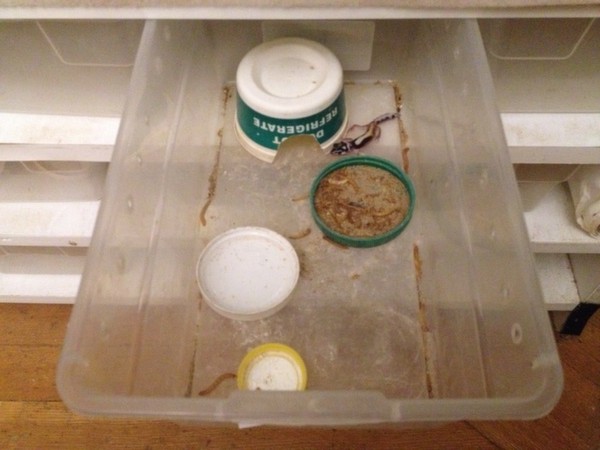
Tubs
Geckos that require humidity without heat also do well in 6qt tubs, but don’t need to be housed in a rack since no heating is required. My gargoyle hatchlings are housed individually in 6qt tubs, each with a cover firmly in place. There is no need to add air holes, since the air exchange is adequate, even with the cover, and the lack of air holes allows the humidity to remain high. Individual tubs can be stacked on a shelf or other piece of furniture. My tubs are furnished with a small hide, piece of cork bark or other type of branch for these semi-arboreal geckos, paper towel substrate, small water dish and bottle cap of fruit gecko diet. Other Rhac species as well as crested geckos can be easily housed this way.
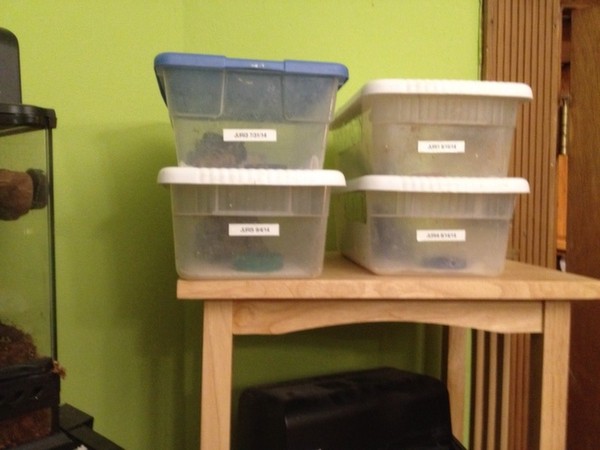

Cage Stacks
In all honesty, I am not that fond of racks. If I’m going to have geckos, I want to be able to see them, not have them shelved in drawers.
Currently, my primary breeding projects involve leopard geckos. Most of my leopard gecko hatchlings are housed in front-opening glass enclosures which I get from Glasscages.com (the hinged enclosures are on their “open fronts” page. The half height enclosures are not listed, but can most likely be custom made). My preference is for a size they call “half-’29’s”, meaning that the length and width are that of a 29 gallon aquarium (21.5″x30″) but the height is only half that of a 29 gallon. The actual height of the enclosure I’ve acquired over the years ranges from 81/4″ to 9 1/4″.
The cages are heated with heat cable, taped to the bottom on the outside with Nashua tape, and installed on shelves. The heat cable runs the entire length of the cage, but only half the width, so the back half of each cage is heated, as opposed to the left or right side of the cage.
When hatchlings are small, the cages are divided into 3 sections using plexiglass cut to size. The back of each section is heated and the front is unheated. Although there has been much concern among leopard gecko keepers about providing an adequate temperature gradient in a small space, my summer temperature measuring insures that the gradient does exist (in the same way that it does in a 6qt tub in a rack). Each 30″ long cage can house up to 6 leopard gecko hatchlings, 2 to a section.
As the hatchlings grow, the dividers are removed to provide more space for moving around. Ultimately, young juveniles are housed in groups of up to 6 with multiple dry hides, several humid hides, a dish of calcium, water bowls and food bowls. My preferred substrate is ceramic tile.
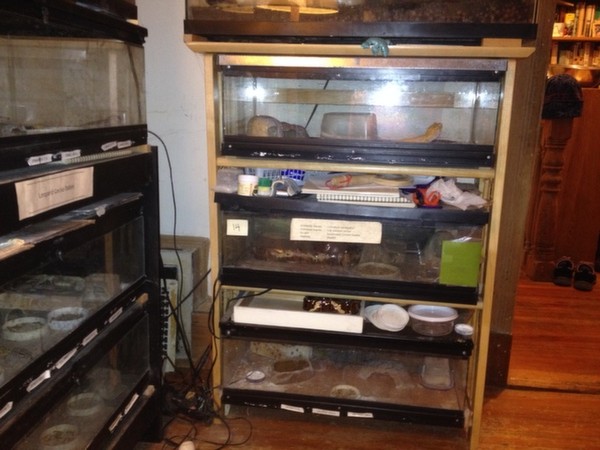
Furnishings
Small geckos prefer small hides so they can feel safe. Hides can be made of small, opaque containers with an opening cut in the side –I use Timberline mealworm cups. They can also be made of terra-cotta saucers that go under planters, with an opening chipped into the side. I also make my own ceramic leopard gecko hides that are glazed to look like gecko hatchlings. Food and water bowls are made from jar lids or the plastic end-caps of the cardboard cylinders that hold crickets. Bottle caps hold calcium. Humid hides for the young hatchlings are made from small tubs of baby food with an opening cut in the side and paper towel (misted nightly) as a substrate.
Micro and Arboreal Species Enclosures
The smaller and more delicate gecko species may, in some cases, need special handling. While many micro geckos do well in heated racks, this may not be appropriate for arboreal and day geckos.
I have had limited experience housing mourning gecko and E. agricole hatchlings. They do well in a 32 ounce deli cup with gauze covered holes at the top (the type of containers used for breeding fruit flies). Add some excelsior (or “wood wool”), a piece of cork bark for climbing and they’re all set. The container can be kept inside the adult enclosure. The biggest problem is opening the top for misting and feeding and preventing escapes.
Another good choice for small, arboreal hatchlings, is the smallest Exo-terra enclosure –the “nano”. Measuring 8″x8″x12″ it’s a good size for tiny hatchlings that may get lost in a bigger vivarium. After failing spectacularly with my L. williamsi hatchlings last season, I have spent the past year preparing a planted nano for what I hope will be a successful 2015 season with these gorgeous geckos.
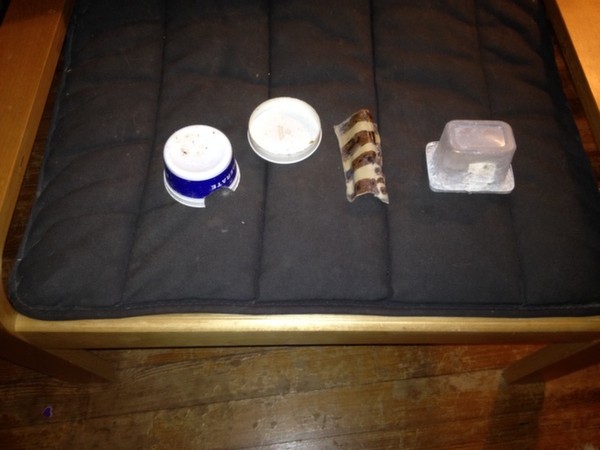
Overruns
Gecko breeding can lead to “too much of a good thing”. As the summer progresses, I start weighing the housing space left against the dates of upcoming reptile shows in the hopes that I’ll sell some geckos before I run out of space. When this doesn’t work out, drastic measures must be taken. The biggest problem is finding space to put enclosures, if one is not lucky enough to have a dedicated reptile room (my dedicated reptile room is also my dedicated living room and dining room!). Space is found under coffee tables, in corners and under existing enclosures for temporary housing.
The temporary enclosures need to be easy to acquire, inexpensive and small, since they often get placed in odd corners and spaces. I have had the most success with: Exo-terra 12″x12″x12″ vivs (get them used and cheap), Exo-terra “faunariums” and “breeding boxes” –the largest has a footprint of 12″x18″, and 5 gallon aquariums. Care must be taken with the plastic enclosures like the faunariums, to use a thermostat with the under tank heater (thermostats are recommended for all enclosures but essential for use with plastic) so the plastic doesn’t burn or melt from overheating.
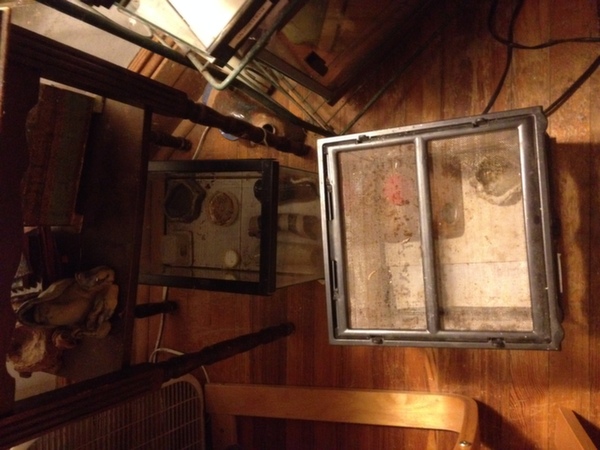


3 Comments
Leave a Reply3 Pings & Trackbacks
Pingback:Gecko Time: Housing Your Hatchlings
Pingback:Gecko Time: Housing Your Hatchlings
Pingback:Show Me Your Baby Bins!